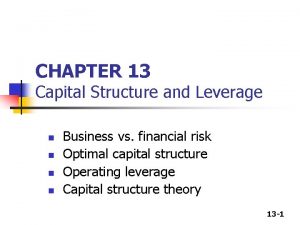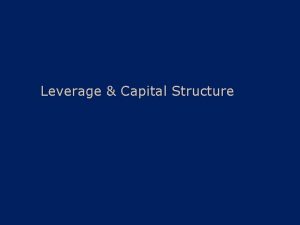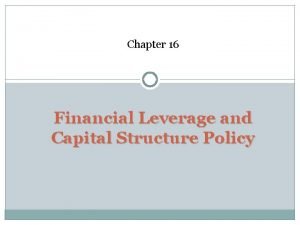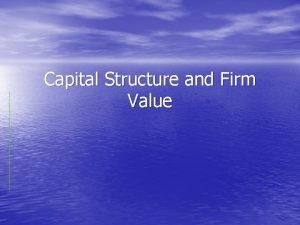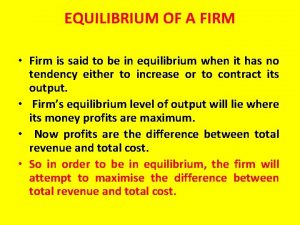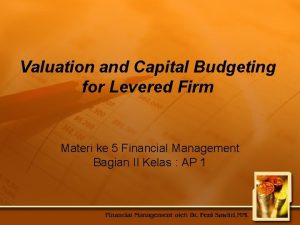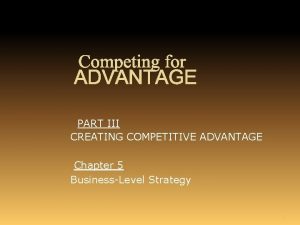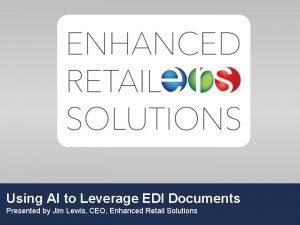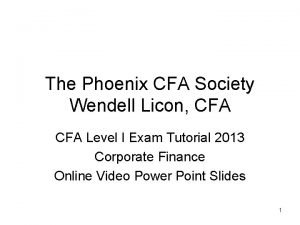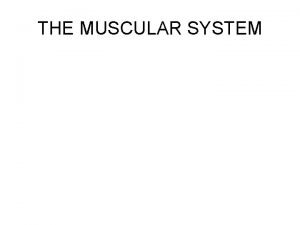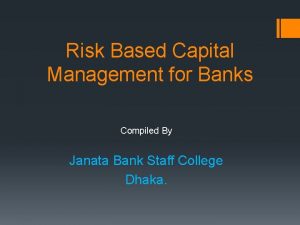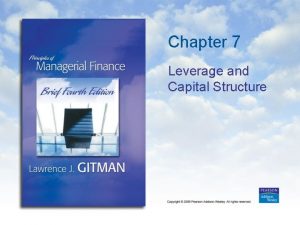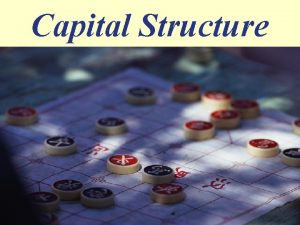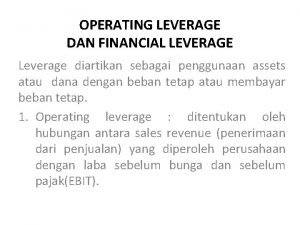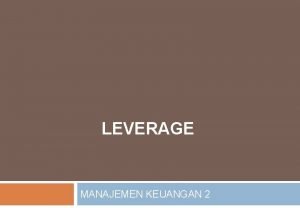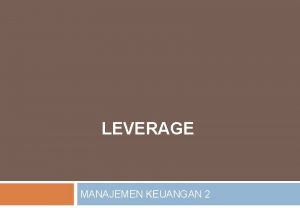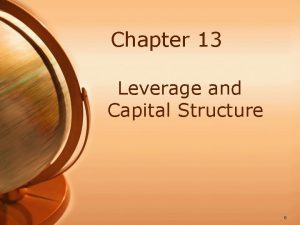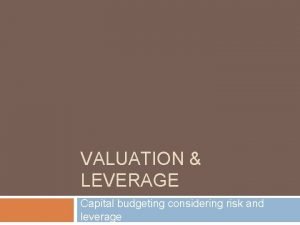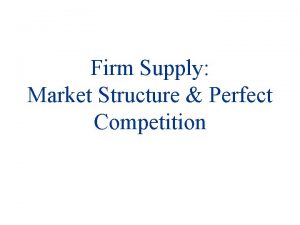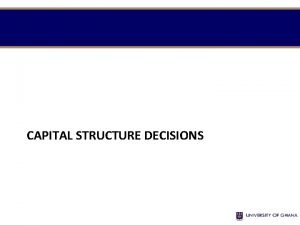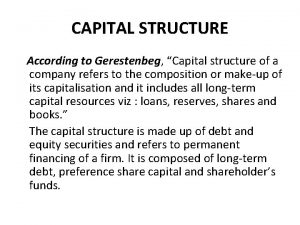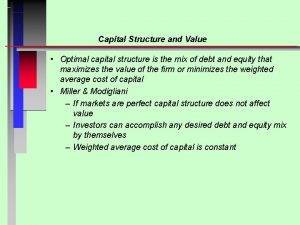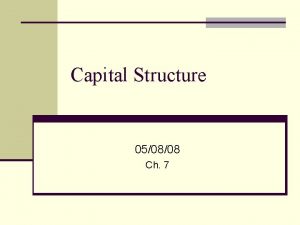Leverage Capital Structure Leverage A firm is said






















- Slides: 22

Leverage & Capital Structure

Leverage A firm is said to be leveraged if it has fixed costs. n There are two types of leverage: n n Operating leverage – fixed costs associated with running the firm. n Financial leverage – fixed costs associated with financing the firm. n Degree of leverage n Measure of how much leverage the firm uses.

Capital Structure n The mix of long-term financial sources used to finance the firm. n It usually refers to the specific proportions of debt, equity, preferred stock, etc. used to finance the firm. n Only long-term sources are included.

Breakeven Analysis n Finding the level of operations necessary to cover all costs. n Can also be used to analyze the level of profitability associated with differing levels of sales. n Operating breakeven point: n The level of sales necessary to cover all operating costs: n The points where EBIT = $0.

A Stylized Approach n The algebra: n PQ-VQ-F=EBIT n (P-V)Q-F=EBIT n Solving for Q when EBIT = $0: n Q=F/(P-V) n Practical problem: n Most companies don’t sell only one product/service, and therefore quantity is not as reliable as sales volume.

Graphical Approach

Graphical Approach

Operating Leverage Operating leverage is the use of fixed operating costs to magnify the effects of changes in sales to the firm’s operating earnings. n Operating leverage is particularly useful if the firm can substitute variable for fixed costs. n

Measuring Op. Leverage n Degree of Operating Leverage: n. Note: As DOL increases, volatility in EBIT (operating earnings) increases.

Financial Leverage n Financial leverage is the use of fixed financial costs to magnify the effects of changes in sales to the firm’s net earnings. n Sources of financial leverage are primarily debt and preferred stock.

Measuring Fin. Leverage n Degree of Financial Leverage: n Note: As DFL increases, volatility in net earnings increases.

Total Leverage Total leverage is the use of any fixed costs to magnify the effect of changes in sales on the firm’s net earnings. n The two components of total leverage are operating and financial leverage. n n Categorizing two components depend on where on the income statement the fixed cost is found.

Measuring Total Leverage n Degree of Total Leverage: n Note: DTL = DOL×DFL.

Capital Structure Theory From WACC we know that the most expensive sources of capital are equity (common stock and retained earnings). n From leverage analysis, we know that adding debt adds risk. n Adding risk adds cost to WACC. n n Therefore adding debt will increase its cost, and the cost of equity.

Capital Structure Theory n The goal of the financial manager is to maximize shareholder wealth: n What level of debt will maximize the value of the firm to the shareholder?

How Much Debt? n The optimal debt level depends on: n Tax Benefit n Tax shield is a component of WACC n Any other tax shields? n Probability n Business of Bankruptcy Risk n Revenue Stability n Cost Stability n Level of Fixed Operating Costs

How Much Debt? n The optimal debt level depends on: n Agency Costs n Risk of expropriation n Place monitoring costs on managers n These monitoring costs can reduce the monitoring costs for equity investors as well.

Other Considerations n Pecking Order Theory: 1) 2) 3) n Use retained earnings Issue more debt Issue common equity Signaling n n Asymmetric information Debt is generally seen as a positive signal n Depends on rates and terms

The Optimal Capital Structure

Contrast EPS Method n n The EPS-EBIT approach to capital structure involves selecting the capital structure that maximizes EPS over the expected range of EBIT. Using this approach, the emphasis is on maximizing the owners returns (EPS). A major shortcoming of this approach is the fact that earnings are only one of the determinants of shareholder wealth maximization. This method does not explicitly consider the impact of risk.

EPS-EBIT Approach to Capital Structure (cont. )

EPS Shortcoming n n n Although EPS maximization is generally good for the firm’s shareholders, the basic shortcoming of this method is that it does not necessary maximize shareholder wealth because it fails to consider risk. If shareholders did not require risk premiums (additional return) as the firm increased its use of debt, a strategy focusing on EPS maximization would work. Unfortunately, this is not the case.
 What is the degree of operating leverage
What is the degree of operating leverage Chapter 13 leverage and capital structure gitman ppt
Chapter 13 leverage and capital structure gitman ppt Capital structure leverage
Capital structure leverage Financial leverage and capital structure policy
Financial leverage and capital structure policy Capital structure and firm value
Capital structure and firm value Multinational cost of capital and capital structure
Multinational cost of capital and capital structure Multinational cost of capital and capital structure
Multinational cost of capital and capital structure A firm is said to be in equilibrium when
A firm is said to be in equilibrium when Why according to robin and jay are people funny
Why according to robin and jay are people funny Valuation and capital budgeting for the levered firm
Valuation and capital budgeting for the levered firm Working capital introduction
Working capital introduction Difference between capital reserve and reserve capital
Difference between capital reserve and reserve capital Difference between capital reserve and reserve capital
Difference between capital reserve and reserve capital Basle ii
Basle ii Regulatory capital vs economic capital
Regulatory capital vs economic capital Constant vs variable capital
Constant vs variable capital Capital allocation line vs capital market line
Capital allocation line vs capital market line Organizational structure specifies the firm's:
Organizational structure specifies the firm's: How to leverage edi
How to leverage edi Equivalent annual annuity
Equivalent annual annuity Muscles of posterior thigh
Muscles of posterior thigh High leverage point vs outlier
High leverage point vs outlier Pillar of basel ii
Pillar of basel ii

